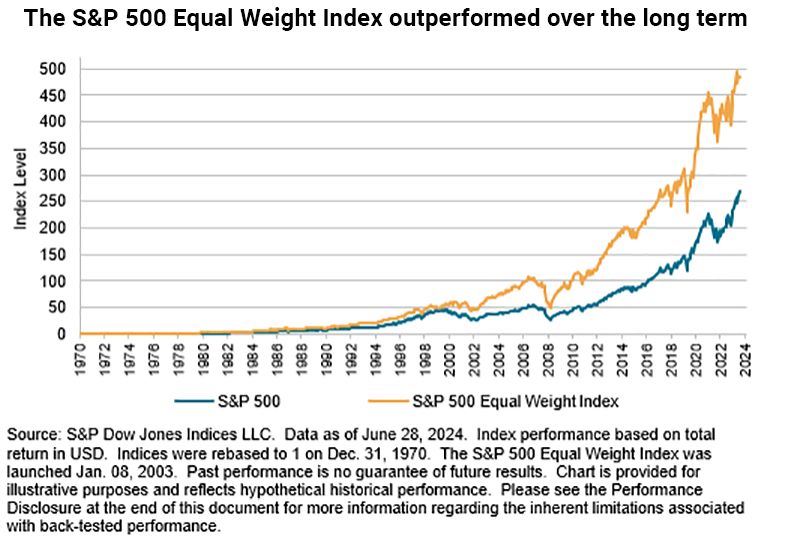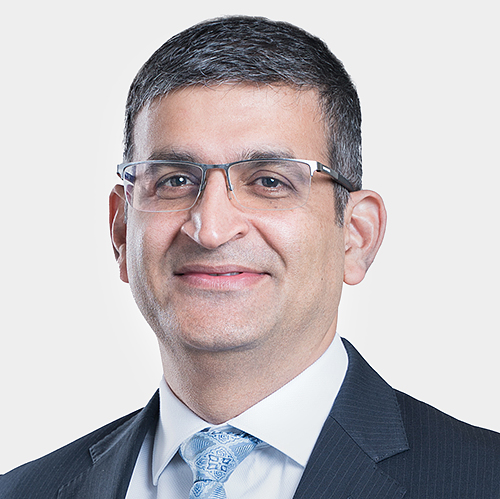Equity investors who are concerned about their portfolios being dominated by a few big technology stocks, are beginning to reallocate some of their assets to exchange-traded funds (ETFs) with equal-weighted benchmarks to avoid concentration risks.
ETFs that use equal-weighted indices as their underlying benchmarks, allow investors to gain exposure to all stocks in the index, as well as across all sectors to achieve a more balanced exposure. This is in contrast to indices that use the traditional market capitalization weighting.
Although using equal-weighted indices as benchmarks is not new, there has been renewed interest in this investment strategy over the past 12 months, particularly in the United States, where the equity market is alarmingly concentrated on a few stocks in a single sector – the so-called Magnificent Seven (Apple, Microsoft, Google parent Alphabet, Amazon.com, Nvidia, Meta Platforms and Tesla) in the technology sector.

Global trend
This is evident in the fact that ETFs using equal-weighted indices as benchmarks have been gaining assets globally as investors rebalance their portfolios.
In Asia, Mirae Asset Management launched the Tiger S&P500 Equal Weight ETF on July 23 for its Korean investors. The fund, which aims to provide a more balanced exposure across large, mid, and small-cap stocks, has a market capitalization of around 101.3 billion won (US$72 million), making it one of the largest ETFs in Korea linked to the S&P 500 index.
In the US, the Chicago Mercantile Exchange (CME Group) launched on February 26 the E-mini S&P 500 Equal Weight futures contracts with the S&P 500 Equal Weight Index as the underlying benchmark. The product is designed to provide investors with a diversified exposure to the broader US equity market without concentrating on larger firms, which dominate the S&P 500.
On the ETF front, an established ETF catering to US investors, which also uses the S&P 500 Equal Weight Index as the underlying benchmark, is the Invesco S&P 500 Equal Weight ETF (RSP), which has assets under management (AUM) of US$37.25 billion as of September.
In Europe, DWS offers the Xtrackers S&P 500 Equal Weight UCITS ETF with AUM of £5.69 billion (US$7.45 billion) as of August, and the Xtrackers S&P 500 Equal Weight ESG UCITS ETF (focusing on ESG criteria) with US$20 million in AUM.
Still in Europe, UBS offers the UBS ETF (IE) MSCI World Socially Responsible UCITS ETF, which incorporates equal weighting with an emphasis on sustainability. As of the end of August, this ETF has £1.12 billion in AUM.
Long-term strategy
In an interview with The Asset, Tim Edwards, global head of index investment strategy at S&P Dow Jones Indices (S&P DJI), says: “What's happening is investors are choosing this (equal-weighted) investment strategy for the long term. Sometimes it’s strategic, sometimes its tactical. I think the mega caps have overrun. They want to keep their US equity exposure, but they also want to diversify more by bringing money into equal-weight strategies. And that's something we've seen around the world, not just in the US but also in Europe and also, through cross-listings, in Asia and other regions.”
Edwards says an equal-weight strategy allows investors to remain invested in equities, as represented by the S&P 500 which has been overperforming, while diversifying across all stocks in the index. Thus, they avoid being over concentrated in a few large-cap stocks that may be dominating the index at a certain period.
The US equity market has been recently characterized, among other features, by strongly extended price trends and the relative dominance of a few mega-cap companies. This could make equal-weight strategies particularly interesting for two reasons, he says. First, trends in concentration and momentum tend to reverse at some point, even if it is hard to identify when that will occur. Second, diversification strategies can be more important when markets are relatively concentrated.
The S&P 500 Equal Weight Index has outperformed the S&P 500 over more than two decades of live history, with a similar long-term rate of excess returns observed over a hypothetical back-tested history extending back to 1970 (see graph).
“These observations are not new, but an equal-weight approach to large-cap US equities may be of particular interest in times such as the present, when the equity markets are at high levels of market concentration relative to history,” Edwards says.
He says one of the risks of investing in an equal-weight strategy is, if the biggest companies continue to grow and become an increasing part of the US market. “Then equal-weight indices, which are, you know, egalitarian in their approach, will miss out because they give the same allocation to these market heroes as they do to every other stock in the S&P 500,” he explains.









